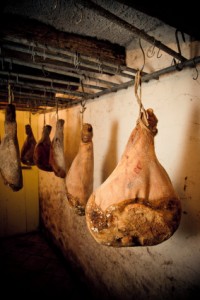 Curing meats is a great way to preserve them. It may seem like a difficult chore to get into, but in reality, curing meat is not that complex. Curing simply means preserving meat. For thousands of years, people have cured meats by drying, salting, or smoking them. Any kind of meat can be treated this way, but pork usually gives the best results. Because this type of preservation has been used for so long, it is a method that you can rely on even if you have no power. Of course, there are modern pieces of equipment you can use to make curing easier and safer, but you can still use traditional methods as a safe way to get well-cured meats.
Curing meats is a great way to preserve them. It may seem like a difficult chore to get into, but in reality, curing meat is not that complex. Curing simply means preserving meat. For thousands of years, people have cured meats by drying, salting, or smoking them. Any kind of meat can be treated this way, but pork usually gives the best results. Because this type of preservation has been used for so long, it is a method that you can rely on even if you have no power. Of course, there are modern pieces of equipment you can use to make curing easier and safer, but you can still use traditional methods as a safe way to get well-cured meats.
How Curing Works
Commercially-cured meats often contain many objectionable chemicals. You can make the same product at home with fewer preservatives and with a better flavor. All you have to do is dry the meat out. When all or most of the water is gone from meat, bacteria cannot live in it, and you have a safe product that lasts a long time. Getting your meat dried out relies on several factors:
- Size. The larger the piece of meat, the longer it will take to dry it out.
- Temperature. Higher temperatures will speed the process of curing.
- Fat. The more fat a piece of meat has, the longer it takes to cure.
- Salt. Salt is the primary drying agent when curing meats. The more salt you use, the faster the meat will cure.
- pH. A higher pH means a slower curing process.
Essentially, you introduce salt to your meat and let it dry out until it is cured. Of course, there are several considerations beyond this simple premise, especially to ensure that you end up with a product that is safe to eat.
Learn How To Process Your Own Deer Harvest Faster And Easier …
The Ingredients
While it is a simple process to cure meats, there are some ingredients that are absolutely essential to get a tasty product that looks appealing and is free from dangerous bacteria.
- Meat. Of course, you need a meat to cure. You can use pork, beef, veal, lamb, poultry, and fish. Various cuts of pork will give you the best color and flavor. Lamb, veal, and beef can be cured, but they lose much of their protein and nutrients in the process. Poultry and fish do well in the curing process.
- Salt. Salt is the most important ingredient in curing, next to the meat of course. Table salt, or sodium chloride, draws the water out of the meat. It also draws water out of and kills microorganisms in the meat.
- Sugar. Sugar is not a required ingredient for making cured meat; however, you will want to use it for flavor. It acts to cut the harsh flavor of the salt.
- Nitrates and nitrites. It may seem as if these ingredients are modern preservatives, but in fact, people have been using them for centuries. Saltpeter, or salt with nitrates, has long been used to cure meats, even before people knew what nitrates were. Nitrates and nitrites act to kill bacteria in the meat, but they also give the meat a nice pink color. Without them, you will have gray meats. These compounds can be harmful to people in large quantities, so follow recipes carefully and never use more than is suggested.
The Set Up
It is possible to cure meats by simply leaving them to hang in a garage, barn, shed, or similar outbuilding. However, you can get much better results by creating a space in which you can control humidity, temperature, and airflow. To make a tasty and safe cured meat, you need to be able to control all three factors. The temperature for your curing area should be between 50 and 60 degrees Fahrenheit. At temperatures above 60 degrees, bacteria will be able to grow, and below 50 degrees, it will slow the curing process too much. Humidity needs to be between 70 and 75 percent. If it gets below 70, your meat will dry out too quickly on the outside while the inside will become spoiled. If the humidity is too high, you run the risk of the meat not drying out and of growing bad mold on it. Airflow is necessary because it helps to dry the meat and prevents the growth of these bad molds.
To get all the right conditions, you can either use a location you already have that meets the requirements, or you can create one. Get a temperature and humidity sensor to determine when you have the right conditions. If you have a cellar or basement, you may be already there. Check the temperature and humidity to find out. If so, simply fan your meats a couple of times a day for air flow.
If you don’t have a good location already, you can make one. An old refrigerator works well. You can use a timer and sensor to turn the fridge on and off in an effort to keep the interior at just the right temperature. You should be able to find such a controller with a quick online search. To get the humidity level right, you can place a bowl of salt water in the bottom of the fridge and monitor the humidity with a sensor. It can be tricky to get it just right this way, so alternatively, you can put a small humidifier in the fridge with a controller that keeps it set at the right percentage. For airflow, drill a few holes in each side of the fridge and cover them with mesh to keep rodents out.
The Recipes
Recipes for curing meats are very detailed and require more attention than the space of this article. Once you have a good set up ready, though, you can start looking at recipes to use. Make sure you find a reliable source and that you follow the measurements precisely. You need to get the ingredients right to make a safe product. Rest assured, though, that after you have tried curing once or twice, you will find it easy to make delicious meats and sausages.
Safety
Safety is more important than any other consideration when making cured meats. This is a very safe way to preserve meat, but as with any type of preservation, there is always a risk. If you do it right and follow some guidelines, you should have no safety concerns.
- When in doubt, throw it out. This is the number one safety rule when curing meats. While the risk of dangerous bacteria may be low, the result of consuming contaminated meat is severe enough to not take any chances. The danger is highest at the beginning of the process, so keep your eye on the meat early on to look for bad signs. Look for bad mold, which is green, black, or furry. At any sign of bad mold, throw it out. Good mold is white and powdery. It should smell like ammonia. Another bad sign is when the outside of the meat hardens. This means the drying happened too quickly and the interior is probably still moist and could be harboring bacteria.
- Keep your conditions in the right ranges. Check on your meat regularly to make sure the humidity is between 65 and 80 percent and that the temperature is between 50 and 60 degrees Fahrenheit.
- Use the nitrates and nitrites. These ingredients sometimes get a bad rap, but they are essential for creating a safe product. They can be the only thing that stops you from getting botulism from a piece of meat. The risk of getting botulism from your meat is quite low, but because of the severity of the illness, you need to use the nitrates and nitrites so that your risk goes down to zero. Handling pure nitrates and nitrates is dangerous, so use prepared cure mixes. They will have the right amount of ingredients that you need.
- Dry to 35 percent. Recipes that you follow should tell you how long to cure your meat, but you can also use weight to determine when it’s ready. Weigh your meat before curing, and weigh it again when you think it is done. If it has lost 35 percent of its weight, it is safe to eat. An exception would be if you think you have case hardening. In that situation, the weight may have gone down enough, but the moisture loss occurred only on the outside. The interior could have too much moisture still and be unsafe. If you suspect case hardening, throw it out.
©2012 Off the Grid News
 Off The Grid News Better Ideas For Off The Grid Living
Off The Grid News Better Ideas For Off The Grid Living




